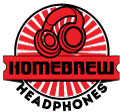Tuning (Voicing) Headphones
In this article I cover the basics of the art and science of voicing headphones. It’s not intended to be the definitive guide, but a practical guide that when combined with some experimentation, will get you to an awesome sounding pair.
Before I built my first pair of headphones, I searched high and low in books and online for info on how to voice headphones. Unlike loudspeakers where there are theoretical models of great practical application, for headphones there were none. John Borwick’s Loudspeaker and Headphone Handbook has plenty of theory, but little of practical use. Therefore I had to figure if all out from scratch. This article is a distillation of my main findings.
If you’re interested in digging deeper into my work, you can read about the test setup here and see the results here.
Equipment
Before you start, you’ll need a means of measuring frequency response curves. Professional equipment costs mega-bucks, so here are two affordable options:
- MiniDSP EARS: this is the easiest, but at USD$199 not the cheapest option. In my experience, repeatability is not great, so you need to average multiple measurements to be sure a design change is causing the change in response, not measurement variation. One advantage of MiniDSP EARS is that you can make meaningful comparisons to other peoples’ measurements made with EARS.
- DIY rig: the cheapest option is to create an MDF rig to hold a microphone. It should have two plates approximately one head width apart and hold a microphone to the centre of one side. This won’t compensate for the ear’s effect on the frequency response, but you can achieve very repeatable results. In my opinion, the repeatability makes this the best option. Microphone options include MiniDSP UMIK-1 and Dayton Audio EMM-6.
For software, I recommend REW, which can be downloaded here for free.

MiniDSP EARS

DIY Test Rig
General Approach To Voicing Headphones
The approach I recommend is to measure the baseline frequency response of your headphones and a target pair you like the sound of, then tune yours to get as close as possible to the ‘target’, then adjust to your own personal taste. This approach will give good results even if your test rig doesn’t compensate for the ear’s effect on the frequency response.
Voicing headphones requires a different approach than designing loudspeakers. Assuming you’re using off-the-shelf drivers, you can amplify or attenuate the bass a lot more easily than the treble. Therefore if your headphones are too bass heavy, you should attenuate the bass and vice versa if if they are too treble heavy.
The picture below shows the qualitative effects of things you can easily change. Using plasticine to block leaks, experiment until you get close to your target. Don’t forget to have a listen along the way!

There are a few other items that will affect the sound, but their impact is either small or they’re difficult to control:
- Cushion hair leaks: leaks between the cushions and your skin due to hair will attenuate the bass. The same is true if the headband angle is not correct or cushions don’t seal the baffle properly.
- Cushions: different cushion materials and designs will affect the sound, as I have outlined in this blog post. As I am assuming you’re using what’s readily available off the shelf, I haven’t gone into much depth on this, but it could be worth experimenting with if you can’t get a great result with the techniques above.
- Drivers: these will affect the sound, so consider voicing different drivers to see which gets you to the best result. Off-the-shelf choices are very limited though.
- Putting foam damping material in the rear cavity had very little impact on the sound.
An Example
Using Dayton Audio CE38MB-32 drivers and Bose replacement cushions, the baseline Homebrew Headphones design was way too bass heavy (see red line below). The solution was to block all except one driver rear vent and to only spot glue the driver in (ie allow some baffle leak). The resulting frequency response curve is much flatter and closer to the Grado SR225 target:

Conclusion
I hope you have found this article useful. If you have any feedback, comments or suggestions, please email me at [email protected]
Happy headphone building!
Did you receive more than a coffee worth of value from this website? If so, I’d be super grateful if you helped make this website break even! Thanks!
